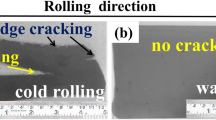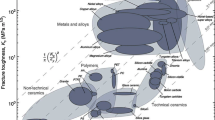Abstract
The fatigue crack growth in cold-rolled (CR) and annealed (AN) polycrystalline superelastic NiTi shape memory alloys under cyclic stressing are investigated. The fatigue crack growth morphologies of compact tension specimens are recorded. Experimental results show that the main cracks of the AN specimens grow along the original crack plane, while the crack paths of the CR specimens orient at 18\(^{o}\) angle to the original horizontal crack plane. The latter is due to the strong anisotropy of elastic modulus and hardness after the cold rolling. Besides, the fatigue crack growth rates of the AN specimens in the regime of \(\Delta K=4~\hbox {MPa}\sqrt{\mathrm{m}}\sim 9~\hbox {MPa}\sqrt{\mathrm{m}}\) are lower than those of the CR ones. The AN specimens have higher fatigue crack growth resistance than the CR specimens due to the stronger shielding mechanism caused by plastic deformation and reduced anisotropy by annealing.






Similar content being viewed by others
References
Mohd Jani J, Leary M, Subic A, Gibson MA. A review of shape memory alloy research, applications and opportunities. Mater Des. 2014;56:1078–113.
Duerig T, Pelton A, Stöckel D. An overview of nitinol medical applications. Mater Sci Eng A-Struct. 1999;273–275:149–60.
Schaffer JE. Structure–property relationships in conventional and nanocrystalline NiTi intermetallic alloy wire. J Mater Eng Perform. 2009;18(5–6):582–7.
Delville R, Malard B, Pilch J, Sittner P, Schryvers D. Transmission electron microscopy investigation of dislocation slip during superelastic cycling of Ni-Ti wires. Int J Plast. 2011;27(2):282–97.
Ahadi A, Sun Q. Effects of grain size on the rate-dependent thermomechanical responses of nanostructured superelastic NiTi. Acta Mater. 2014;76:186–97.
Suresh S. Fatigue of materials. 2nd ed. Cambridge: Cambridge University Press; 1998.
Yin H, He Y, Moumni Z, Sun Q. Effects of grain size on tensile fatigue life of nanostructured NiTi shape memory alloy. Int J Fatigue. 2016;88:166–77.
Ahadi A, Sun Q. Grain size dependence of fracture toughness and crack-growth resistance of superelastic NiTi. Scr Mater. 2016;113:171–5.
Ritchie RO. The conflicts between strength and toughness. Nat Mater. 2011;10(11):817–22.
Mckelvey AL, Ritchie RO. Fatigue-crack growth behavior in the superelastic and shape-memory alloy nitinol. Metall Mater Trans A. 2001;32(3):731–43.
Moumni Z, Zaki W, Maitournam H. Cyclic behavior and energy approach to the fatigue of shape memory alloys. J Mech Mater Struct. 2009;4(4):395–411.
Hanlon T. Grain size effects on the fatigue response of nanocrystalline metals. Scr Mater. 2003;49(7):675–80.
Li Y, Li JY, Liu M, Ren YY, Chen F, Yao GC. Evolution of microstructure and property of NiTi alloy induced by cold rolling. J Alloys Compd. 2015;653:156–61.
Ahadi A, Matsushita Y, Sawaguchi T, Sun QP, Tsuchiya K. Origin of zero and negative thermal expansion in severely-deformed superelastic NiTi alloy. Acta Mater. 2017;124:79–92.
LePage WS, Ahadi A, Lenthe WC, Sun Q-P, Pollock TM, Shaw JA. Grain size effects on NiTi shape memory alloy fatigue crack growth. J Mater Res. 2017;33(02):91–107.
Gao S, Yi S. Experimental study on the anisotropic behavior of textured NiTi pseudoelastic shape memory alloys. Mater Sci Eng A-Struct. 2003;362(1):107–11.
Robertson SW, Ritchie RO. In vitro fatigue-crack growth and fracture toughness behavior of thin-walled superelastic Nitinol tube for endovascular stents: a basis for defining the effect of crack-like defects. Biomaterials. 2007;28(4):700–9.
Otsuka K, Sawamura T, Shimizu K. Crystal structure and internal defects of equiatomic TiNi martensite. Phys Status Solidi. 1971;5(2):457–70.
Oliver WC, Pharr GM. An improved technique for determining hardness and elastic modulus using load and displacement sensing indentation experiments. J Mater Res. 1992;7(6):1564–83.
Nye JF. Physical properties of crystals: their representation by tensors and matrices. Oxford: Oxford university press; 1985.
Hammond C. Book review: The basics of crystallography and diffraction (2nd edn). Meas Sci Technol (2002);13(2):232.
Prokoshkin S, Brailovski V, Dubinskiy S, Inaekyan K, Kreitcberg A. Gradation of nanostructures in cold-rolled and annealed Ti-Ni shape memory alloys. Shape Mem. Superelast. 2016;2(1):12–7.
Kulkarni AV. Transformation behaviour and unusual twinning in a NiTi shape memory alloy ausformed using equal channel angular extrusion. Philos. Mag. 2005;85(16):1729–45.
Ahadi A, Sun Q. Stress hysteresis and temperature dependence of phase transition stress in nanostructured NiTi—effects of grain size. Appl Phys Lett. 2013;103(2):207–597.
Paris PC. A critical analysis of crack propagation laws. Transasme Serd. 1963;85(4):528–33.
Melin S. The influence of the T-stress on the directional stability of cracks. Int J Fracture. 2002;114(3):259–65.
Smith DJ, Ayatollahi MR, Pavier MJ. On the consequences of T-stress in elastic brittle fracture. Proc R Soc A-Math Phys. 2006;462(2072):2415–37.
Robertson SW, Gong XY, Ritchie RO. Effect of product form and heat treatment on the crystallographic texture of austenitic Nitinol. J Mater Sci. 2006;41(3):621–30.
Qian L, Sun Q, Xiao X. Role of phase transition in the unusual microwear behavior of superelastic NiTi shape memory alloy. Wear. 2006;260(4):509–22.
Xia M, Liu P, Sun Q. Grain size dependence of Young’s modulus and hardness for nanocrystalline NiTi shape memory alloy. Mater Lett. 2018;211:352–5.
Wolf E. Fatigue crack closure under cyclic tension. Eng Fract Mech. 1970;2(1):37–45.
Ritchie RO. Mechanisms of fatigue crack propagation in metals, ceramics and composites: Role of crack tip shielding. Mater Sci Eng A-Struct. 1988;103(1):15–28.
Acknowledgements
The authors are grateful for the financial support of this work from the National Natural Science Foundation of China (Project Nos. 11532010 and 11602176) and the Hong Kong Research Grants Council (GRF Project No. 16214215).
Author information
Authors and Affiliations
Corresponding authors
Rights and permissions
About this article
Cite this article
Chen, J., Yin, H., Kang, G. et al. Fatigue Crack Growth in Cold-Rolled and Annealed Polycrystalline Superelastic NiTi Alloys. Acta Mech. Solida Sin. 31, 599–607 (2018). https://doi.org/10.1007/s10338-018-0056-0
Received:
Revised:
Accepted:
Published:
Issue Date:
DOI: https://doi.org/10.1007/s10338-018-0056-0




